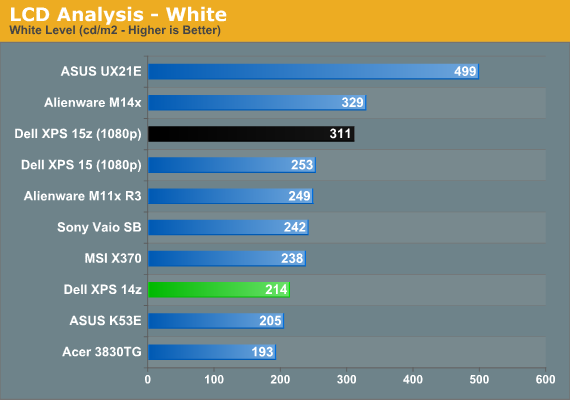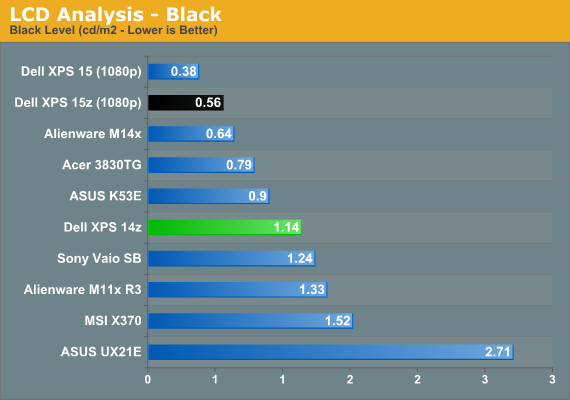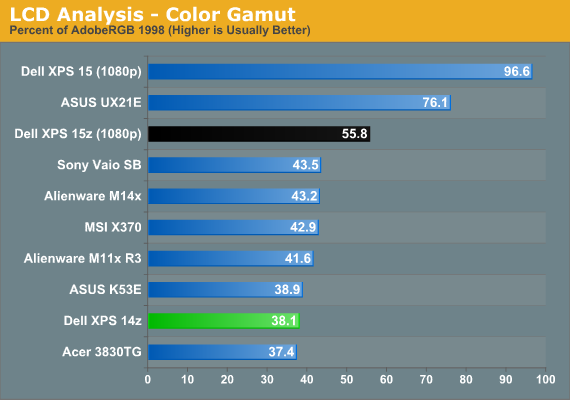Dell XPS 14z: Thoroughly Reviewed
by Jarred Walton on October 24, 2011 9:00 AM ESTThe Screen: A Crying Shame
We’ve seen so many blasé laptop displays over the years that it’s hardly noteworthy anymore, but with the XPS 15 and XPS 15z offering good quality 1080p panels, not to mention the Alienware M14x, M17x, and M18x (the M11x being notably absent), we were hoping for a pleasant surprise. Unfortunately, like the defunct XPS 14 L401x, the XPS 14z is packing a decidedly mediocre LCD panel—and there’s no current option for an upgraded panel.





In order of importance, maximum brightness and contrast are the first two areas where we like to see good results. Looking at our global database of laptop displays, only the top third (often in high-end laptops costing $2000 or more) even manage a 500:1 contrast ratio, which is the bare minimum we’d like to see. Likewise, only the top 20% or so manage at least 300 nits maximum brightness. The panel in the 14z ranks in the bottom third for brightness and the bottom 20% for contrast. Not surprisingly, color gamut is also very low, at just 38% of AdobeRGB—that’s the fourth lowest gamut we’ve measured in nearly two years. Given those results, the color accuracy is almost meaningless, though it also rates in the bottom third.
The viewing angles of the LCD don’t help the situation. From head on, the display looks fine, and we still like the thin left and right bezels. However, off angle viewing is highly prone to color shift, and vertical viewing angles need to be within about a 10 degree arc to be useful. Compare the viewing angles with the Dell XPS 15z and you’ll see why we desperately want the option for an upgraded LCD panel—a 1440x900 display would be ideal.
















60 Comments
View All Comments
cloudgazer - Monday, October 24, 2011 - link
Apple upgraded the CPUs on their MBP line literally this morning, so the final comparison is a bit off.JarredWalton - Monday, October 24, 2011 - link
Written earlier than this morning, but I appreciate the update. Apple still likes skimping on the RAM and fleecing you for RAM upgrades, but we can't expect much else.cloudgazer - Monday, October 24, 2011 - link
No arguments there. First law of Apple is to buy your own RAM - though you always have to hang on to the original Apple supplied SODIMM in case you have to use AppleCare.S.D.Leary - Monday, October 24, 2011 - link
Thats odd. Every time I have used Applecare, I've had aftermarket RAM in my system, and they have never even mentioned it.SDLeary
lukarak - Monday, October 24, 2011 - link
They even offer guides on how to replace it. Of course they are not going to mention it.tipoo - Saturday, February 25, 2012 - link
Changing RAM doesn't void the warrenty on the rest of the Mac, they just don't cover the new RAM.jecs - Monday, October 24, 2011 - link
My current mobile computer is a Macbook Pro 2.0 from 2008 but I will wait more for my next laptop. However I am not looking for performance there. What I want is a very good screen, decent graphics and a nice and solid construction that could last for 3-4 years more. For performance I work with desktops.XLNC - Monday, October 24, 2011 - link
I'm glad they brought attention to the horrid screen. We've been stuck with 1366x768 for far too long, because the vast majority don't understand what "resolution" means and get the cheapest laptop possible. This is one area where I applaud Apple, they provide high quality, high-res (16:10 in some cases!) screens. However, my search for a compact Windows laptop with a quality screen continues.FlyBri - Monday, October 24, 2011 - link
I hear ya, which is why I caved and bought a MBA to run Windows 7. Quality is so far above anything else, it's completely worth it.Johnmcl7 - Monday, October 24, 2011 - link
I wouldn't say so, Apple have always been slow with their screens particularly in resolution as rivals (particularly Dell and Sony) have been offering much higher resolution screens. Apple have been slow with higher resolution 13in panels, they're only offering the 1400x900 now whereas Sony have had 1600x900 13.1in panels for a couple of generations of their Z series and with the last generation were offering a 1920x1080 13.1in panel. I don't really understand how Apple have managed to get this reputation for screens given they're years behind their competition, the RGB LED backlit screens have been out a couple of years now but no sign of them on an Apple machine.I also disagree about what people think of resolutions, I don't think it's a case that vast majority don't want higher resolution. I'm a resolution junkie and my machines use high resolution panels but most people that use any of my machines find the resolution too high and want to turn it down and at work there's a surprising number of people who find their 17in 1280x1024 screens too high and run them at 1024x768 (which looks terrible as it's the wrong aspect ratio).
John